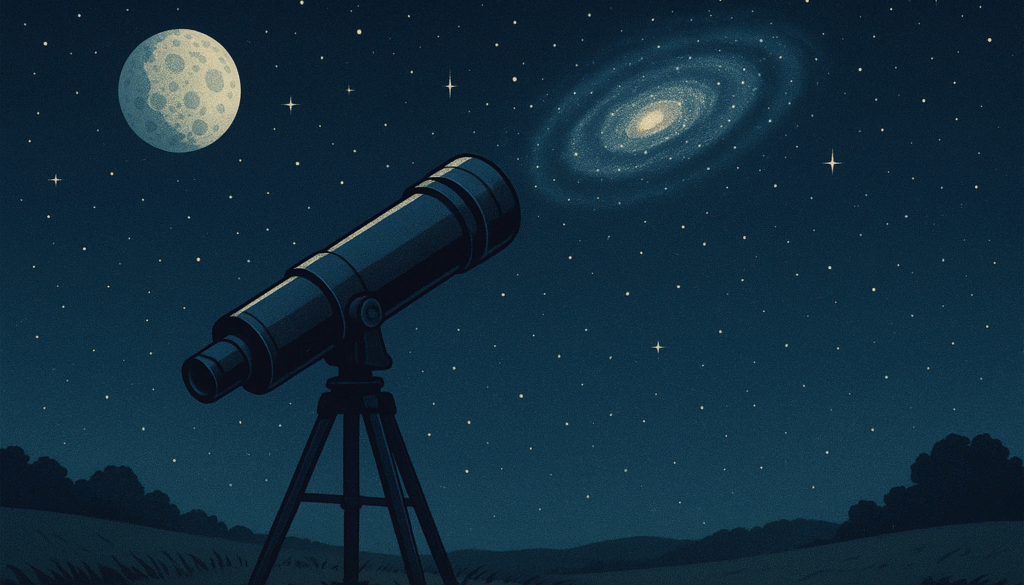Explore the Universe from Your Home with a Telescope
Have you ever looked up at the night sky and wondered:
⭐ How far away are those stars?
🌙 How close does the Moon really look?
🪐 Can you actually see Saturn and its famous rings with your own eyes?
With a high-quality telescope, the mysteries of the universe suddenly become part of your view — right from your backyard.
Modern telescopes aren’t just for scientists in observatories; they’re designed for everyone, from curious beginners to dedicated stargazers. With the right one, you can explore the Moon’s craters, track Jupiter’s moons, or even dive into distant galaxies.
Choosing the Right Telescope
Currently, based on factors such as lens arrangement, the type of radiation the telescope receives, and external conditions it can withstand, there are three common types of telescopes that are frequently used:
Refracting Telescope: Operates on the principle of light refraction, using lenses to collect and converge light.
Reflecting Telescope: Works on the principle of light reflection, using mirrors to gather and focus light.
Compound Telescope: Combines the structures of both reflecting and refracting telescopes, using both lenses and mirrors to directly capture light. This type delivers sharper images than the others and is especially suitable for photographing distant celestial objects.
Each type has its strengths, but beginners often start with refractors for simplicity or Dobsonian reflectors for their bright, clear views of the night sky.
Applications of Telescopes
Telescopes are not only used to observe outer space objects but also serve various other purposes:
Observing celestial bodies from Earth’s surface: Today, telescopes can be used by both amateurs and professionals to observe celestial objects from the ground. To further space exploration, many countries have built large observatories with powerful telescopes capable of observing planets and stars millions of kilometers away. Some world-famous observatories include San Fernando Observatory (Spain), Mauna Kea (Hawaii), Roque de los Muchachos and Teide Observatories (Canary Islands), and Cerro Pachón Inter-American Observatory (Chile).
Collecting accurate data about celestial objects so that scientists can make predictions, hypotheses, and strategies to deal with cosmic phenomena that may affect Earth.
Analyzing images and light: These analyses not only serve as valuable field data but also allow scientists to determine where light waves originate, as well as establish the chemical composition of the light-emitting body. This helps identify details such as structure, atmosphere, and age of the celestial object.
In short, telescopes are indispensable tools for exploring the sky, celestial bodies, and advancing the science of astronomy. That is why telescopes are now highly sought after, both by amateur users and professional researchers.
So, where can you buy a quality telescope you can truly rely on?
Buying Guide: Choosing the Right Telescope
A telescope can be a big investment, so here are a few things to keep in mind:
- Aperture size is the most important feature — it determines how much light your telescope gathers, and therefore how much you can see.
- Portability matters if you want to take it to darker skies away from city lights.
- Mount type can make or break the experience — simple mounts are easy for beginners, while equatorial or computerized mounts help track objects across the sky.
- Budget is key. There are great telescopes under $200, while more advanced models can run into the thousands.
Top Telescopes for Beginners
For beginners who are just getting started with astronomy, here are some recommended telescope products you can explore.
- Superior Optics: 400mm(f/5.7) focal length and 70mm aperture, fully coated optics glass lens with high transmission coatings creates stunning images and protect your eyes. Per…
- Magnification: Come with two replaceable eyepieces and one 3x Barlow lens.3x Barlow lens trebles the magnifying power of each eyepiece. 5×24 finder scope with mounting bracket…
- Wireless Remote: This refractor telescope includes one smart phone adapter and one Wireless camera remote to explore the nature of the world easily through the screen and take…
- 【Excellent Optics】Astronomical telescope features 80mm aperture 600mm(f/6.7) focal length-The big aperture can capture more light; high transmission multi-fully coated optical…
- 【Portable & Stable】Our refractor telescope has a backbag, an adjustable aluminum tripod and an upgraded phone adapter. All accessories can be packed into the bag, which is con…
- 【Easy to Operate】 This telescope is easy to assemble even for astronomy beginners and kids. You can set up easily with the detail installation manual and video. No tools are r…
- Optimum Magnification: Our telescope for kids and adults is quipped with two replaceable excellent-quality eyepieces (25mm and 10mm) for 24X and 60X magnification. 3x Barlow l…
- Excellent Quality Optics: This telescope is 600mm(f/6.7) focal length and 80mm aperture, 80mm aperture to capture more light picture and multi-fully high transmission coated a…
- Portable And Convenient: Comes with a phone adapter and an adjustable aluminum tripod. Wireless remote control and carrying bag make it easier for you portable and capture ama…
- Superior Optics: Dianfan astronomy telescope features a focal length of 800 mm and a fully coated 90 mm objective lens. The large aperture gathers more light for brighter, clearer …
- Powerful Magnification: With two eyepieces and a 3× Barlow lens, this telescope offers 32×–240× magnification. It allows you to observe craters and lunar seas on the surface of the…
- Quick Setup & Beginner-Friendly: User-friendly design with clear instructions makes assembly simple—ready in about 15 minutes. Smooth focusing helps you quickly locate targets. Per…
- Optimum Magnification & Easy Object Locating: Equipped with two high-quality eyepieces (25mm and 10mm) for 24X and 60X magnification, and a 3x Barlow lens that triples the magnific…
- Excellent Optical Quality: With a 600mm focal length (f/6.7) and 80mm aperture, this telescope captures more light for brighter images. The multi-layer fully coated all-optical len…
- Portable & Convenient for Easy Stargazing: This telescope comes with a phone adapter, adjustable aluminum tripod, wireless remote control, and a carrying bag, making it portable an…
Frequently Asked Questions
Can you really see Saturn’s rings with a telescope?
– Yes! Even a small beginner telescope makes Saturn’s rings visible.
What’s the best telescope for a beginner?
– The Celestron AstroMaster 70AZ is one of the most user-friendly choices.
Do I need a telescope for astrophotography?
– Yes, and compound or computerized telescopes are best suited for this.
Ready to Begin Your Cosmic Journey?
A telescope is more than just a tool, it’s your personal window to the universe. The right telescope will help you to admire the craters on the Moon, track Jupiter’s moons, or dive into deep-sky objects. Check out our top picks and find the perfect telescope for your first night under the stars!






